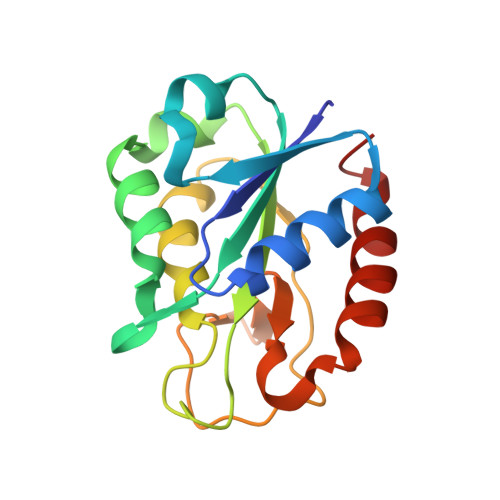Discovery of Specific Flavodoxin Inhibitors as Potential Therapeutic Agents Against Helicobacter Pylori Infection.
Cremades, N., Velazquez-Campoy, A., Martinez-Julvez, M., Neira, J.L., Perez-Dorado, I., Hermoso, J., Jimenez, P., Lanas, A., Hoffman, P.S., Sancho, J.(2009) ACS Chem Biol 4: 928
- PubMed: 19725577
- DOI: https://doi.org/10.1021/cb900166q
- Primary Citation of Related Structures:
2W5U - PubMed Abstract:
Helicobacter pylori establishes life-long infections in the gastric mucosa of over 1 billion people worldwide. In many cases, without specific antimicrobial intervention, H. pylori infected individuals will develop type B gastritis, chronic peptic ulcers and, more rarely, gastric neoplasias. Conventional antimicrobial therapy has been complicated by dramatic increases in resistance to macrolides, metronidazole and fluoroquinolones. Here, we report the development of novel therapeutics that specifically target the unique flavodoxin component of an essential metabolic pathway of H. pylori. With the use of high-throughput screening methodology, we have tested 10,000 chemicals and have identified 29 compounds that bind flavodoxin, four of which interrupted in vitro electron transfer to flavodoxin physiological partners. Three of these compounds are bactericidal and promisingly selective for H. pylori. The minimal inhibitory concentrations of two of them are 10 times lower than their minimal cytotoxic concentrations for HeLa cells. Importantly, neither of the four inhibitors is toxic for mice after administration of 1-10 mg kg(-1) doses twice a day for 5 days. Enzymatic, thermodynamic and structural characterization of the inhibitor-flavodoxin complexes suggests these compounds could act by modifying the redox potentials of flavodoxin. These newly discovered inhibitors represent promising selective leads against the different diseases associated to H. pylori infection.
Organizational Affiliation:
Departamento de Bioquimica y Biologia Molecular y Celular, Facultad de Ciencias, Universidad de Zaragoza, Spain.
















